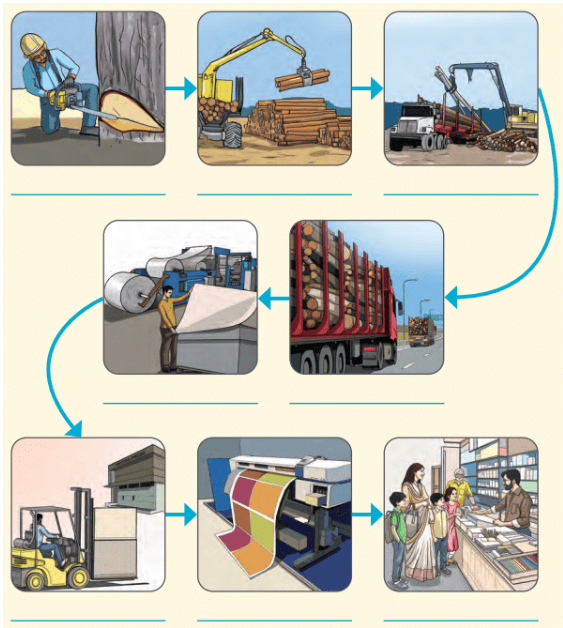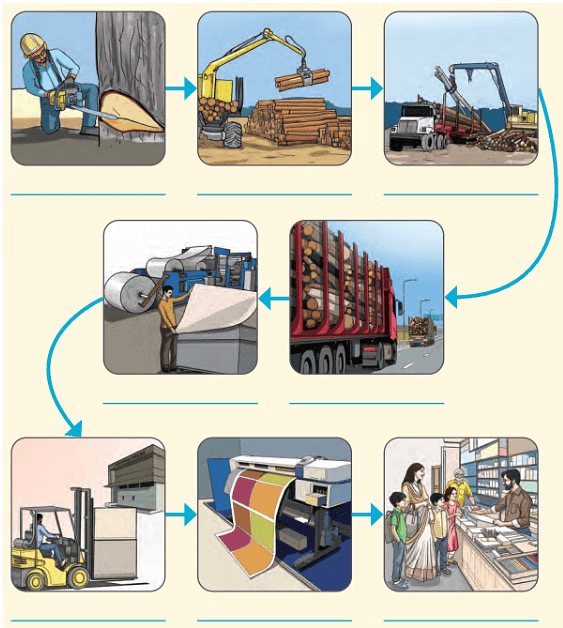Economic Activities Around Us NCERT Solutions | Social Studies for Class 6 PDF Download
| Table of contents |

|
| Questions, Activities and Projects |

|
| The Big Questions |

|
| Let’s Explore |

|
| Think About It |

|
Questions, Activities and Projects
Q1: What is the primary sector? How is it different from the secondary sector? Give two examples.
Ans: The primary sector involves activities that directly depend on natural resources, such as agriculture, fishing, and mining. It is different from the secondary sector, which involves processing raw materials from the primary sector into finished goods. Examples of primary sector activities include farming and fishing. Examples of secondary sector activities include manufacturing cars and producing textiles.
Q2: How does the secondary sector depend on the tertiary sector? Illustrate with a few examples.
Ans: The secondary sector depends on the tertiary sector for various services that support its operations, such as transportation, banking, and marketing. For example, a car manufacturing company (secondary sector) relies on transportation services (tertiary sector) to deliver raw materials to its factories and distribute finished cars to dealerships. It also depends on banking services for financial transactions and loans.
Q3: Give an example of interdependence between primary, secondary and tertiary sectors. Show it using a flow diagram.
Ans:
The Big Questions
Q1: How are economic activities classified?
Ans: Economic activities are classified into three main sectors: primary, secondary, and tertiary. These sectors group activities based on their nature and the role they play in the economy.
Q2: What differentiates these activities to be grouped into sectors?
Ans: The differentiation of economic activities into sectors is based on the nature of the work and the resources involved:
- Primary sector activities involve the extraction and harvesting of natural resources.
- Secondary sector activities involve the transformation of raw materials into finished goods through manufacturing and construction.
- Tertiary sector activities involve the provision of services that support the primary and secondary sectors as well as provide services directly to consumers.
Q3: How are the three sectors interconnected?
Ans: The three sectors are interconnected as they rely on each other to function and sustain the economy:
- The primary sector provides raw materials to the secondary sector.
- The secondary sector processes these raw materials into finished products.
- The tertiary sector offers services such as transportation, marketing, and sales that help in distributing these products to consumers.
Let’s Explore
Page 200
Q: Now that we have seen some examples of secondary sector activities, can you name two more economic activities in the secondary sector?
1.
2.
Ans: 1. Food industry: converting fruits/vegetables into jams, sauces, pickles etc.
2. Chemical industry: converts raw materials (oil, natural gas, air, water, metals and minerals) into commodity chemicals for industrial and consumer products.
Page 207
Q: Label the pictures in the illustration shown in Fig. 14.1 on page 206 as:
1. Primary sector
2. Secondary sector
3. Tertiary sector Ans:
Ans:
1. Primary
2. Primary
3. Tertiary
4. Tertiary
5. Secondary
6. Secondary
7. Secondary
8. Tertiary
Page 208
Q: List the economic activities in your neighbourhood and label them appropriately as primary, secondary or tertiary. Draw arrows to show how they are connected to each other. In what ways are they dependent on each other? What would happen if one of the activities ceased to exist?
Ans: Economic Activities in a Neighbourhood:
Primary Sector:
- Agriculture: Growing fruits and vegetables on local farms.
- Fishing: Catching fish from a nearby lake.
Secondary Sector:
- Food Processing: A small factory turning local produce into canned goods.
- Textile Manufacturing: A workshop making clothes from raw cotton.
Tertiary Sector:
- Retail Stores: Shops selling fresh produce, canned goods, and clothes.
- Transportation Services: Trucks moving goods from farms and factories to stores.
- Banking: A local bank providing financial services like loans.
- Healthcare: A clinic offering medical help to residents.
Connections and Dependencies:
- Agriculture (Primary) → Food Processing (Secondary) → Retail Stores (Tertiary): Farms supply food to the factory, which then sends processed goods to shops.
- Fishing (Primary) → Retail Stores (Tertiary): Fish from the lake are sold in local stores.
- Textile Manufacturing (Secondary) → Retail Stores (Tertiary): Clothes made in the workshop are sold in stores.
- Transportation Services (Tertiary): Trucks move products between farms, factories, and shops.
- Banking (Tertiary): Banks support businesses in all sectors by providing loans and financial services.
- Healthcare (Tertiary): The clinic ensures workers across all sectors stay healthy.
Interdependence:
- The Primary Sector (farming, fishing) supplies the raw materials for the Secondary Sector (factories).
- The Secondary Sector processes these materials into products sold by the Tertiary Sector (shops).
- Transportation Services are essential for moving goods between farms, factories, and stores.
- Banking helps keep businesses running by offering financial support.
- Healthcare maintains a healthy workforce, allowing all sectors to function well.
What Happens if One Activity Stops?
- If agriculture stops, food processing factories won’t have raw materials, and stores will run out of food.
- If transportation stops, goods won’t move from farms and factories to shops, causing a disruption.
- If banking services stop, businesses may struggle to get funds, slowing down the economy.
- Without healthcare, workers will become less healthy, reducing productivity in all sectors.
This shows how every sector is important and connected to keep the neighbourhood’s economy running smoothly.
Think About It
Page 199
Q: Can you think of any primary activities that you may have seen in the past? What are the natural resources used in these activities? Name two of them and discuss your experiences with your classmates.
1.
2.
Ans:
Two examples of primary activities based on my experiences:
1. Agriculture (Farming)
- Natural Resources Used: Soil, water, seeds, and sunlight.
- Experience: I’ve seen farmers preparing fields, planting seeds, and harvesting crops like wheat and rice. The process relies on natural resources like fertile soil and water. It’s amazing to witness how a bare field transforms into a productive farm, and the farmer's efforts directly influence the outcome, which changes with the seasons.
2. Fishing
- Natural Resources Used: Water bodies (rivers, lakes, seas), fish, and aquatic plants.
- Experience: I’ve watched fishermen casting nets in rivers, using skill and patience to catch fish. Their success depends on the health of the water and ecosystem. It’s fascinating to see how they use traditional methods to find fish-rich spots and how their livelihood is connected to the environment.
These examples show how closely primary activities depend on natural resources and the environment.
Page 207
Q: Observe the different stages of the process shown in Fig. 14.1 on page 206 and discuss them with your fellow classmates. Ans: Stages of the Process:
Ans: Stages of the Process:
- Extraction of Raw Materials: The first step is cutting down a tree, which represents obtaining raw wood from nature. This is a Primary Sector activity, where natural resources are extracted directly from the environment.
- Transportation of Raw Materials: The second and third steps show logs being loaded onto trucks and moved to a processing facility. This step involves Tertiary Sector activities, as it supports the primary sector by transporting raw materials to where they are needed.
- Processing of Raw Materials: The fourth step involves turning raw wood into paper. This is a Secondary Sector activity, where raw materials are transformed into usable products.
- Manufacturing and Packaging: The fifth and sixth steps depict paper being processed further, possibly printed with text or images, and then packaged. These are also Secondary Sector activities that prepare the product for sale.
- Distribution and Retail: The final step shows the finished products, like books, being sold in a store. This is a Tertiary Sector activity, where goods are made available to consumers, completing the process.
Discussion Points:
- Interdependence: The primary, secondary, and tertiary sectors all depend on each other. The raw materials from the primary sector are processed by the secondary sector, and the tertiary sector ensures these goods reach consumers.
- Economic Value Addition: At every stage, value is added to the raw materials, turning them into products that can be sold for profit.
- Environmental Impact: The process, particularly the extraction of raw materials, affects the environment. Sustainable practices should be considered at each stage.
This shows how different sectors of the economy collaborate to produce the everyday goods we use.
|
46 videos|231 docs|28 tests
|
FAQs on Economic Activities Around Us NCERT Solutions - Social Studies for Class 6
| 1. What are the main types of economic activities? |  |
| 2. How do economic activities impact our daily lives? |  |
| 3. What is the relationship between economic activities and employment? |  |
| 4. Why is it important to understand economic activities in our community? |  |
| 5. How do economic activities contribute to the development of a country? |  |
















